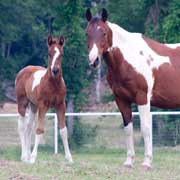|
Breaking Up Is Hard To DoBy Kenton H. Arnold, DVM
Weaning foals is a necessary evil when you are in the business of breeding horses. Every mare owner must go through it. If everything goes well and your foal gets through the weaning process healthy and unscathed, you will breathe a sigh of relief. Your dream can continue to grow! If something happens to your prize foal, the work and expense of creating and birthing the foal could be for naught. As an equine veterinarian, I know all too well that horses are accidents waiting to happen, especially babies. As a breeder and horse owner, I know the heartbreak that can come from the loss of a foal. To minimize the possibility of accidents, a well thought out weaning plan should be utilized. There are many ways to wean a foal. The techniques utilized will be different for everyone, depending on the number of foals, the type of facility, and the type of fencing and availability of help. The main thing to remember is to keep your foal safe and as stress-free as possible. Your overall weaning program should start with the some very basic horse ownership measures. A foal should be in excellent health and at a good weight before owners should even consider separating the youngster from the mare. The weaning will be stressful to the foal: therefore all other stresses should be minimized. Foals need to be eating grain and hay (approximately one pound per 100 pounds of body weight) each day before the process starts. A good deworming program should already be initiated. Deworming programs usually start when a foal is 30 to 60 days old. Before initiating the weaning process, foals should be halter broken and comfortable being handled. Minor problems can turn into major disasters when separating and weaning babies. If a foal cannot be handled, it could be life threatening if an injury occurs. In the past it has been common to start your vaccination program before weaning. But the new research indicates that the maternal antibodies a foal gets through the colostrum is plentiful and adequate protection for the foal's system. These antibodies actually neutralize the vaccines, not allowing the foal to get protection from the vaccination. It may be more prudent to wait on vaccination until the foal is seven to nine months old. If the immunizations of the mare are questionable, however, then the vaccination program should begin earlier. Your equine veterinarian can help you make the decision. It is very important that the area when the foal is boarded is safe. It needs to be free of potential hazards such as loose or broken boards, exposed nails or eye hooks, inadequate fencing and dangerous feed or water troughs. When in doubt about the safety of an item, remove, and repair or replace it. When making your plans for weaning, try to pick a time when the weather is going to be good. If treacherous weather is expected, post pone your weaning plans until more favorable weather is imminent. Plan to be available to monitor changes and handle problems as they arise. Always use common sense and think safety first when it comes to weaning foals. It is best to wean them as a group. Place all mares and foals together for a minimum of five days before the actual separation takes place. Let the foals get to know each other before moving them from the mothers. After they are comfortable with each other, the mares can be removed. It is important to reduce a mareís grain during the weaning process. This will help the mare to quit producing milk and dry up. The mare should not require any medication to help her dry up. Remember to avoid milking her out this only makes the process longer. The mares and foals will whinny for each other. This is normal. You may decide, however, to totally remove the mare from the property for a few days to decrease the hollering between mother and child. This can also be accomplished by placing the mare in a stall next to the foal. They can see each other but the foal cannot nurse. If you select this technique to initiate your weaning, be sure that the foal cannot get his head through a stall or fence to his mother. He will still be able to nurse and might get injured trying to get to her. This technique can be initiated by gradually separating the mare from her foal for short periods of time and then gradually adding time to the length of separation. It is always best to wean foals together. Horses are herd animals and are less stressed when in groups. A single foal can be weaned with a gelding, if no other foals are being weaned at the same time, this will give the foal a much-needed companion, while making the process easier on everyone.
Equine Veterinary Services
|


©2024 Website Design and Photos by Jim Arnold,
Carroll Brown Arnold and Austria C. Arnold
